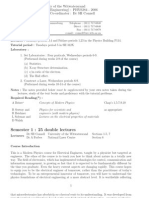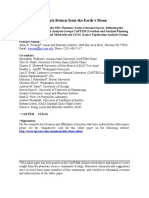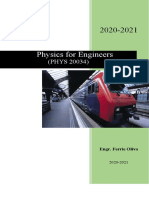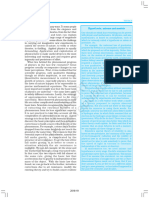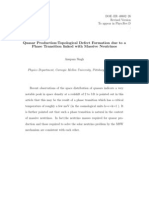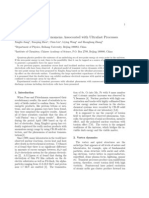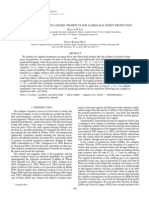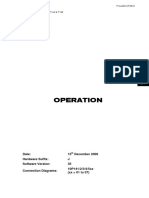Development of Atomic, Molecular and Optical Physics-Based Technologies For Reaching Ultimate Limits in The Fundamental Physics Experiments in Space
Development of Atomic, Molecular and Optical Physics-Based Technologies For Reaching Ultimate Limits in The Fundamental Physics Experiments in Space
Uploaded by
Tuoma2Copyright:
Available Formats
Development of Atomic, Molecular and Optical Physics-Based Technologies For Reaching Ultimate Limits in The Fundamental Physics Experiments in Space
Development of Atomic, Molecular and Optical Physics-Based Technologies For Reaching Ultimate Limits in The Fundamental Physics Experiments in Space
Uploaded by
Tuoma2Original Title
Copyright
Available Formats
Share this document
Did you find this document useful?
Is this content inappropriate?
Copyright:
Available Formats
Development of Atomic, Molecular and Optical Physics-Based Technologies For Reaching Ultimate Limits in The Fundamental Physics Experiments in Space
Development of Atomic, Molecular and Optical Physics-Based Technologies For Reaching Ultimate Limits in The Fundamental Physics Experiments in Space
Uploaded by
Tuoma2Copyright:
Available Formats
Development of Atomic, Molecular and Optical Physics-Based Technologies for Reaching Ultimate Limits in the Fundamental Physics Experiments
in Space A Technology White Paper submitted to the Particle Astrophysics and Gravitation Discipline Program Panel of the Astro2010 Nicholas P. Bigelow1, Scott A. Diddams2, William Farr3, John L. Hall4,2, Will Happer5, Randall G. Hulet6, Kurt Gibble7, Ulf E. Israelsson3, Mark Kasevich8, Wolfgang Ketterle9, John Kitching2, Steven K. Lamoreaux10, Pierre Meystre11, William D. Phillips12, John D. Prestage3, Mark Raizen13, Michael V. Romalis5, Michael Shao3, Robert L. Tjoelker3, Slava G. Turyshev3, Ronald L. Walsworth14, Jun Ye4,2, and Nan Yu3
2
Department of Physics and Astronomy, University of Rochester, Rochester, NY 14627, USA Time and Frequency Division, National Institute of Standards and Technology, Boulder, CO 80305, USA 3 Jet Propulsion Laboratory, California Institute of Technology, 4800 Oak Grove Drive, Pasadena, CA 91109, USA 4 JILA, Department of Physics, University of Colorado, Boulder, CO 80309, USA 5 Department of Physics, Princeton University, Princeton, NJ 08544, USA 6 Department of Physics and Astronomy, Rice University, Houston, TX 77005, USA 7 Department of Physics, The Pennsylvania State University, University Park, PA 16802, USA 8 Department of Physics, Stanford University, Stanford, CA 94305, USA 9 Department of Physics, Massachusetts Institute of Technology, Cambridge, MA 02139, USA 10 Department of Physics, Yale University, New Haven, CT 06520, USA 11 Department of Physics and College of Optical Sciences, University of Arizona, Tucson, AZ 85721, USA 12 Atomic Physics Division, National Institute of Standards & Technology, Gaithersburg MD 20899, USA 13 Department of Physics, University of Texas, Austin, TX 78712 USA 14 Harvard-Smithsonian Center for Astrophysics, 60 Garden Street, Cambridge, MA 02138, USA
Abstract: Recent scientific and technological advances in atomic, molecular, and optical physics (AMOP) have produced new generation of high-precision instruments such as advanced atomic clocks and atomic quantum inertial sensors. Unique performance of these instruments allows addressing many challenging questions related to our understanding of the universe and of the physical laws of Nature. Although remarkably precise, the performance of these instruments is often limited by terrestrial conditions. On the other hand, space offers superior experimental conditions and a wide range of unique scientific opportunities. In particular, AMOP technologies are expected to bring about a new generation of high-accuracy tests of Einsteins general theory of relativity, to improve sensitivities of future gravitational wave observatories, to offer unique methods of probing the physics beyond the Standard Model, etc. In addition, cold-atom-based atomic clocks and quantum inertial sensors are naturally suited for precision investigations in many areas of astronomy and astrophysics. We describe the new AMOP-based technologies, their benefits for space research and the rational for dedicated support of their development, size and power reduction, and space qualification efforts in the next decade. Programs in fundamental physics will be a unique opportunity to consolidate this new technology and prepare key instruments for future space missions. A well-defined program with modest investments on the order of $70M will beget new capabilities that could enable major scientific advances in fundamental physics, astronomy and astrophysics. We emphasizes that the development of the AMOP-based technologies will bring about outstanding scientific results and mature space-proved technology within a plausible time frame of 5 to 10 years. Additional benefits include more robust and advanced ground-based experiments that will further advance the art of measurement science.
Contact information: Dr. Nan Yu Jet Propulsion Laboratory, MS 298 4800 Oak Grove Drive, Pasadena, CA 91109 Phone: (818) 354-4093 Email: nan.yu@jpl.nasa.gov Dr. Slava G. Turyshev Jet Propulsion Laboratory, MS 301-486 4800 Oak Grove Drive, Pasadena, CA 91109 Phone: (818) 393-2600 Email: turyshev@jpl.nasa.gov
An Astro2010 Technology White Paper: AMOP-based Technologies for Fundamental Physics Experiments in Space
1 AMOP-based technologies to addresses the challenges in gravitational physics Today physics stands at the threshold of major discoveries. Growing observational evidence points to the need for new physics. Efforts to discover new fundamental symmetries, investigations of the limits of established symmetries, tests of the general theory of relativity, searches for gravitational waves, and attempts to understand the nature of dark matter were among the topics at the focus of scientific research at the end of the last century. These efforts intensified with the unexpected discovery of the accelerated expansion of the universe (i.e., dark energy) made in the late 1990s, triggering many new activities aimed at answering important questions related to the most fundamental laws of Nature (Turyshev et al., 2009). The fundamental physical laws of Nature are currently described by the Standard Model and Einsteins general theory of relativity. However, there are important reasons to question the validity of this description. Despite the beauty and simplicity of general relativity and the success of the Standard Model, our present understanding of the fundamental laws of physics has several shortcomings. In particular, if gravity is to be quantized, general relativity will have to be modified; however, the search for a realistic theory of quantum gravity remains a challenge. This continued inability to merge gravity with quantum mechanics together with the challenges posed by the discovery of dark energy indicates that the pure tensor gravity of general relativity needs modification or augmentation. It is believed that new physics is needed to resolve this issue. Theoretical models of the kinds of new physics that can solve the problems above typically involve new physical interactions, some of which could manifest themselves as violations of the Equivalence Principle, variation of fundamental constants, modification of the inverse square law of gravity at various distances, Lorentz-symmetry breaking, large-scale gravitational phenomena, and introduce corrections to the current model of spacetime around massive bodies. Each of these manifestations offers an opportunity for experiment and could lead to a major discovery. Space is one of the most likely places where these manifestations may be investigated. While providing access to greater variation of gravitational potentials, greater velocities, and full orientation coverage, space also extends the well-understood and controlled laboratory environments. Ground-based laboratories have seen spectacular developments in Atomic, Molecular and Optical Physics (AMOP) to access measurement regimes with unprecedented sensitivity and accuracy. Progress has led to new instruments and technologies including more accurate atomic clocks, atom-wave interferometers, and femto-second laser combs. Todays new generation of high performance atomic quantum sensors (accelerometers, gyroscopes, gravimeters, gravity gradiometers) is surpassing previous state-of-the-art instruments with novel experimental techniques based on engineered atomic systems. Atomic clocks and quantum inertial sensors represent key technologies for precise measurements of time, frequency, displacement, acceleration, and rotation. Combined with access to large spatial and gravitational variations, these new tools enable more precise experiments in a search for physics beyond the Standard Model and in tests of the general theory of relativity. The questions that can be addressed by space experiments are: Does gravity behave as Einstein predicted?; What will be the nature of a theory of quantum gravity?; Where and how will the Standard Model fail?; Are the fundamental constants of nature truly constant?; What is the nature of dark matter and dark energy? Many projects in fundamental physics would greatly benefit from having access to measurement precisions that have already been demonstrated by atomic quantum sensors based on cold atom physics. Today, atomic clocks approach a precision of few parts in 1017 in the measurement of time and frequency; on the ground, atom interferometers promise sensitivities of 108 m/s2/Hz1/2
Page 1 of 10
An Astro2010 Technology White Paper: AMOP-based Technologies for Fundamental Physics Experiments in Space
for acceleration measurements and of 109 rad/s/Hz1/2 for the detection of tiny rotations. These accuracies are already surpassing the performances of instruments presently in use. However, putting these instruments in space can further improve their already remarkable precision by additional orders of magnitude, thus enabling new classes of fundamental physics investigations. A new generation of high-precision fundamental physics experiments requires ultra-high accuracy metrology of distance, accelerations, rotations, and time. For instance, the present generation of ground-based torsion-balance tests of gravitational inverse-square law (ISL) operates at distances of tens of microns limited by the terrestrial conditions. At the same time, many modern fundamental physics theories predict violations of the ISL at shorter distances, typically below 1 micron. New technologies are needed to access such short ranges. Similarly, future space-based gravitational wave observatories will have to control proof mass acceleration noise below the level of 1014 m/s2/Hz1/2 at very low frequency, currently a significant challenge. On the other hand, instruments in space relying on cold-atom-based technologies with truly drag-free atoms as proof masses offer an unmatched potential in resolving these challenges. Among the promising new AMOP-based technologies are highly stable and accurate frequency standards and clocks, atomic quantum sensors, and octave-spanning femtosecond laser combs. Space is a unique environment for improving the performances of these new devices and pushing to the limits the experiments testing the fundamental laws of physics. Space can ensure infinitely long and unperturbed free fall conditions, long interaction times, quiet environmental conditions and absence of seismic noise, absence of atmosphere, large free-propagation distances and variations in altitude, large velocities, and large variations of the gravitational potential. In this white paper we discuss these new AMOP-based technologies, including their current status, anticipated performance, challenges of space deployment, and science benefits from their use in space-based research. We also argue for dedicated support for their development, miniaturization, and space qualification efforts in the next decade. 2 Emerging Technologies: frequency standards and atomic quantum sensors The field of AMOP has had an incredibly productive decade marked by Nobel Prizes awarded for discoveries in laser cooling (1997), Bose-Einstein condensation and atom lasers (2001), and laser-based precision spectroscopy and the optical frequency comb technique (2005). The field is now mature both from the point of view of the understanding of the basic physics underlying laser cooling and laser manipulation of atoms and for the development of a solid technology for the experimental implementation of new quantum devices. Below we present the details. 2.1 Highly-accurate optical clocks 2.1.1 The nature of technology innovation For many years microwave transitions have served as the basis for highly accurate and ultrastable atomic clock systems. Laser cooling and trapping of ions and neutral atoms achieve extremely low temperatures where systems of confined atoms can be well controlled. New ultrastable optical reference cavities achieve laser stabilization to one part in 1015 in 1 sec. A new type of clocks based on optical atomic transitions promises dramatic improvements. In an optical atomic clock, a laser in the visible region of the electromagnetic spectrum is used to induce a forbidden atomic transition. By using optical frequencies (0 1015 Hz) rather than microwave frequencies (0 1010 Hz), an optical clock operates with a much smaller unit of time. This leads to an enormous improvement in stability and also to a higher accuracy since several key frequency shifts are fractionally much smaller in the optical domain.
Page 2 of 10
An Astro2010 Technology White Paper: AMOP-based Technologies for Fundamental Physics Experiments in Space
The measurement of optical frequencies has recently been made practical by the advent of the self-referencing (octave spanning) optical frequency combs (OFC) of femtosecond lasers. With OFC it is possible to phase-coherently link optical frequencies to microwave frequencies, so that lasers can be used to count seconds and can be compared to traditional microwave clocks. Combined with narrow linewidth lasers, this has made possible the first generation of optical atomic frequency standards and clocks based on cold trapped neutral atoms and ions. 2.1.2 Present state of the art Present-day liter-sized trapped-ion microwave space clocks have demonstrated fractional frequency stability of 31013 1/2 and are capable of reaching the 1015 level over a few hours of integration time (Prestage & Weaver, 2007). Cold atom microwave clocks with similar performance are operating in metrology labs and a version is being space qualified for the International Space Station (ISS) (Laurent et al. 2007). The current accuracy of fountain clocks is at better than the 41016 level, while ground-based trapped-ion clocks have demonstrated fractional frequency stability of 210-14 1/2, capable of reaching the low 10-16 level over a few hours of integration time. Short-term performances of microwave clocks are mostly limited by the available ultra-stable quartz oscillators at the 1013 level, though more complicated cryogenically cooled sapphire oscillators can achieve stabilities at the 10-15 level. Highly stabilized lasers as optical oscillators have already routinely achieved the 1015 1/2 level, limited by the thermal noise of the reference cavity (Ludlow et al. 2007). When referenced to suitable optical transitions of atoms in ion traps or optical lattices, an experiment of trapped ion clocks has already demonstrated fractional frequency stability of a just over 1017 in several 103 seconds (Rosenband et al., 2008). At the same time, the strontium optical lattice clock has now reached 1016 accuracy (Ludlow et al., 2008), limited at this time by blackbody radiation induced uncertainty. Accuracies better than 1017 are expected in the near future. 2.1.3 Scientific benefits of new technology Clock comparison is a major method for probing the special theory of relativity and Lorentz invariance. Access to space enables better clock performance and allows to fully benefit from the larger variations of the background gravitational environment. Specifically, clocks made with different atoms or different kinds of transitions (electronic, hyperfine, vibrational for molecules), when moved together can search for violations of the Equivalence Principle (EP). Monitored over time, they look for variations of the fundamental constants. Identical clocks moved relative to each other can be used to perform tests of special and general relativity tests, etc. As direct consequence of the EP, general relativity and other metric theories of gravitation forbid any time variation of non-gravitational constants. Today, optical clocks offer the possibility to test time variations of fundamental constants at a high accuracy level. Such measurements complement the tests of the local Lorentz invariance and of the universality of the free fall to experimentally establish the validity of the EP. Furthermore, clocks of 1016 or better accuracy and associated ability of time transfer can be used for geodesy through gravitational redshift. Ancillary Earth sciences will greatly benefit from the use of these improved clocks including studies of Earth rotation, climate research, ocean research, earthquakes, tsunamis, etc. Space experiments have been proposed for free flyer spacecraft and for onboard the ISS (Turyshev et al., 2007). As optical clocks have shown potential for greater precision than microwave clocks, missions using optical clocks have already been proposed under the European Space Agency (ESA) Cosmic Vision program. Clock experiments in space can also help to answer the
Page 3 of 10
An Astro2010 Technology White Paper: AMOP-based Technologies for Fundamental Physics Experiments in Space
intriguing question of time variations in the fundamental constants. The proposed SpaceTime mission was an atomic-clock mission designed to search for a variation of the fine-structure constant with a spacecraft that flies to within six solar radii of the sun (Prestage & Maleki, 2004). Optical metrology technologies can also benefit other astrophysics and astronomy missions. For instance, microwave oscillators at only the 1013 level are used on the Cassini spacecraft for radio science experiments. An advanced optical technology at the 1015 level would greatly improve the measurement sensitivity. Future optical ranging in deep space will require a laser at the 11015 1/2 level, and highly stabilized lasers will improve space laser interferometry similar to LISA and planetary search missions using very long based line interferometry and formation flight. Measurements of the constancy and isotropy of the speed of light can be performed by continuously comparing a space clock to a ground clock. Tests based on this technique have already been performed in 1996 by comparing clocks on-board GPS satellites to a hydrogen maser. Optical clocks orbiting around the Earth combined to a time and frequency transfer link not degrading the clock performances can improve present results by about four orders of magnitude. Optical clocks could measure the gravitational red-shift with a relative uncertainty of few parts in 108, demonstrating a new efficient way of mapping the Earth gravity field and define the shape of the geoid at the cm level. At the same time, the comparison of two optical clocks based on appropriately chosen transitions during free flight in a varying gravitational potential can test the universality of the gravitational red-shift at the same accuracy level. 2.1.4 Benefits and challenges of space deployment In space, where weightlessness and the extremely quiet environment ensure the ideal conditions for laboratory experiments, the clock performances can be improved even further. Clocks in space represent unique tools to test fundamental laws of physics at an unprecedented level of accuracy and to develop applications in time and frequency metrology, universal time scales, global positioning and navigation, and geodesy. The absence of a strong gravity bias also benefits operation of an atom trap. A much weaker trap and therefore lower atom cloud temperatures can be achieved in microgravity. Thus, a releasedatom or slow-beam clock could benefit from colder temperatures. In addition, reduced vibration in space will also be very beneficial for optical clocks. Space deployment puts stringent requirements on size, mass, power, and autonomy of an instrument. A small trapped Hg+ clock for deep space missions is presently being developed and is near NASA Technology Readiness Level (see, TRL) of 5 with a volume of ~2 liters, 2 kg mass, and requires 20W of electrical power. While that clock uses no lasers, optical clocks extensively rely on stabilized lasers. This is one of the major challenges in developing space optical clocks and metrology. For a space-qualified optical clock, lasers must be small and reliable with long lifetimes while working under harsh space radiation environment. High-power lasers (~1W) are required for many neutral atom cooling and trapping techniques, ultra-stabilized lasers (~11015 1/2) for clock transitions, and femtosecond lasers (one octave frequency span) for optical frequency comb generation and selfreferencing. In addition, ultra-high vacuum systems with good optical access are required for housing trapped atoms. The vacuum chambers should ideally be completely sealed enclosures without the active pumps typically used in laboratories. All corresponding precision microwave and laser control
Page 4 of 10
An Astro2010 Technology White Paper: AMOP-based Technologies for Fundamental Physics Experiments in Space
electronics need to be specifically developed for the space instrument. All systematic effects must be extremely well controlled. 2.1.5 Objectives, milestones and costs Both laser cooled microwave clocks and optical clocks are viable for space operations. Currently demonstrated optical clocks are either based on trapped ions or neutral atoms. Cold-atom-based microwave clocks are a more mature technology and have synergistic technology areas in laser cooling and trapping. Large performance gains are expected by increasing the clock frequency from microwaves regime to the optical. Although small space-qualifiable optical clocks have not been studied in detail, several groups in the US operate optical clocks at TRL 3 (lab demonstration). A program can be established to further advance the advanced atomic clocks for space applications. The program will support an initial development of several advanced clock technologies and common component technologies. It will then focus on one approach for a specific science experiment concept. For optical clocks, TRL 6 could be achievable within a decade with sufficient investment. A Rough Order of Magnitude (ROM) cost estimate for this program is $30M with milestones: 2010-13: stand-alone tabletop breadboard system demonstrations at TRL 4; 2010-13: concurrent component technology development; 2014-16: a compact prototype with advanced laser and optics components at TRL 5; 2016-19: integrated brassboard prototype, TRL 6. 2.2 Atomic quantum inertia sensors 2.2.1 The nature of innovation Atomic quantum inertial sensors exploit the particle-wave duality of atomic particles for ultrasensitive interferometric measurements similar to laser interferometers. Because the rest energy of the atomic particles is on the order of 1011 higher than the energy of a laser photon, atom interferometers can be intrinsically much more sensitive to inertia forces. Recent developments in AMOP for laser control and manipulation of atoms have led to atom optics for atom interferometers. The most successfully used atom optics methods for beam splitting and combining are laser interactions, including simulated Raman transitions, optical grating scattering, and Bloch oscillations in optical lattices. 2.2.2 Present day state of the art Laboratory atom interferometers have achieved da ~ 108 m/s2/Hz1/2 (Peters et al., 1999) as accelerometers and d ~ 61010 rad/s/Hz1/2 (Gustavson et al., 2000) as gyroscopes, already surpassing the state of the art in traditional sensors. Significant advances have been made more recently in the sensor performances and the technology maturity. Various transportable systems are being developed around the world including gravimeters, gradiometers, and gyroscopes. Major advances are still being made today in laboratories. For example, a large momentumtransfer for atom-wave splitting has been demonstrated with a high fringe contrast (Mller et al., 2008). A larger momentum transfer results in a larger effective interferometer area and therefore higher sensitivity for a rotation-sensing interferometer. In addition, the use of coherent quantum matter waves offers potential of further improvement to overcome standard atom projection noise by exploiting quantum entanglement and non-classical states.
Page 5 of 10
An Astro2010 Technology White Paper: AMOP-based Technologies for Fundamental Physics Experiments in Space
2.2.3 Scientific benefits of new technology Atomic quantum inertia sensors can become a key-technology for ultra-precise measurements of accelerations and rotations. Their space deployment can be used to support new classes of experiments such as tests of the gravitational inverse-square law at distances of a few microns, the universality of freefall, and new tests of the EP using atoms, as well as measurements of the relativistic frame-dragging precession (Tino et al., 2007). It also provides new experiment possibilities for gravitational wave detections (Dimopoulos et al., 2008). In addition, new generation of instruments that are using these novel technologies, such as precision gyroscopes, can support precision spacecraft attitude controls for future space telescopes and x-ray observatories. When used as sensitive accelerometers, cold atoms in space as truly drag-free proof-masses provide excellent candidates for tests of the universality of free fall. By measuring the differential acceleration of two co-located matter-wave interferometers with different atomic species, atom interferometers in space can be used to perform highly accurate searches for a violation of the EP, potentially reaching ultimate accuracies in these experiments. The EP is at the foundation of the general theory of relativity and other metric theories of gravity. Such fundamental principle should be tested to its utter most precision. Many modern theories of physics beyond the Standard Model predict a violation of the EP at different levels. The current limits of 11013 on the EP violations are set by ground-based torsion balance experiments (Turyshev et al., 2007, 2009) Atom interferometers in space could be used to reach accuracies beyond these current limits. Thus, the original goal of the Quantum Interferometry Test of Equivalence (QuITE) experiment was to achieve 11016 (Kasevich & Maleki, 2004). More recent advances in the field of matterwave interferometry suggest that even better measurement precisions should be achievable. As sensitive rotation sensor, cold atom interferometers can provide opportunities for mapping the Lense-Thirring precession. A feasibility study of the Hyper-precision cold atom interferometry in space (HYPER) (see HYPER website) that relies on an atom gyroscope orbiting the Earth was recently performed by ESA. Hyper-like missions would be able to investigate two of the fundamental forces of nature: gravity and electromagnetism. For its gravitational investigation, Hyper will precisely map the fabric of the spacetime around the Earth. For its investigation of the electromagnetic force, Hyper will precisely measure the value of the fine structure constant . A direct detection of gravitational waves is one of the most important modern physics experiments. It also offers an invaluable observational tool to probe our universe in astrophysics and cosmology. The detection of gravitational waves requires extremely sensitive detectors and atom interferometers could be used for this purpose. Although it is yet unclear whether there is a significant fundamental advantage of a direct use of atom waves for gravitational wave detection, the use of cold atoms as perfect drag-free proof masses may provide promising technological advantages in reducing acceleration noises to proof masses. Preliminary study indicates that coldatom-based gravitational wave detector can complement LISA and LIGO detectors in providing the coverage for the entire spectrum of gravitational waves (Dimopoulos et al., 2008). 2.2.4 Benefits and challenges of space deployment A flight experiment in microgravity will greatly enhance the performance of atomic sensors because of the long interaction times achievable in a freely falling environment. The much better vibration isolation available in space is also a benefitthe stability of the gratings or light fields that do the beamsplitting affects the phase stability of the atom interferometer, so less vibration is very important. Thus, if used as accelerometers, atom interferometers could potentially reach the
Page 6 of 10
An Astro2010 Technology White Paper: AMOP-based Technologies for Fundamental Physics Experiments in Space
level of da ~ 1012 m/s2/Hz1/2 or better (Yu et al., 2006, Dimopoulos et al., 2008), and if used as gyroscopes d ~ 1011 rad/s/Hz1/2 (see, HYPER). Light-pulse atom interferometer inertial sensors rely on direct laser manipulation of atoms and require lasers similar to those for laser-cooled atomic clocks. Small and reliable space qualified lasers (~1W) with long lifetimes and precise frequency, phase, and intensity control are required. Performance testing and relevant technology validation in the microgravity environment will be challenging. Microgravity validations may be performed in a drop tower, 0-g plane, ISS, or technology demonstration satellite missions. 2.2.5 Objectives, milestones and costs While most of the atomic sensor system developments to date are for terrestrial use, several efforts developing space-based atomic sensors (e.g. QuITE and HYPER), have been undertaken. NASA Earth Science and Technology office has funded an atom interferometer gravity gradiometer development to be used for global gravity mapping in space, now at TRL 4. Maturation of these types of measurement systems for space requires further development of laser and optics systems, optically accessible vacuum systems, high flux atom sources, and low noise atom detection techniques. The potential systematics of atomic quantum sensor based measurement systems will also need carefully studies. In addition, investment should be made to continue basic atom interferometer research activities in laboratories to better understand these inertial sensors, their error sources, and generate new capabilities. A dedicated program for developing atom interferometer based technology for space will encompass a multi-year multi-million dollar effort from universities, research laboratories, and industry. A ROM cost for the program is $30M. A notional schedule for developing a cold atom accelerometer suitable for experiments using cold atoms as drag-free proof masses is given below. 2011-10: instrument concept formulation and design study; 2012-14: key system development to TRL5 including physics package, laser & optics system for cold atoms, interferometer laser system, microwave & control electronics; 2015-17: TRL 6 package development; 2018-19: system integration and microgravity tests. 2.3 Femtosecond laser combs in space 2.3.1 The nature of technology innovation Mode-locked femtosecond lasers generate highly accurate combs of frequency markers in the optical region of the spectrum, these being the Fourier frequency components of the emitted pulse trains. Two dramatic developments in recent years have revolutionized the use of these frequency combs. First, the comb lines have demonstrated phase coherence to one part per 1019. Second, a self-referencing technique stabilizes the carrier-envelope phase offset across a comb span of greater than one octave. By relating optical and microwave frequencies in a phase coherent way these technologies make precision optical clocks possible. They also offer the possibility of revolutionizing the practice of laser ranging in both frequency and time domains. 2.3.2 Present state of the art Optical frequency combs (OFC) enable a phase coherent link between the microwave frequencies of atomic clocks (~1010 Hz) with optical frequencies (~1015 Hz); a comparison at 10-17 level has been demonstrated (Rosenband et al., 2008) with the residual uncertainty of <10-19.
Page 7 of 10
An Astro2010 Technology White Paper: AMOP-based Technologies for Fundamental Physics Experiments in Space
Femtosecond Ti:Sapphire mode-locked lasers or fiber mode-locked lasers are presently commercially available and tabletop stabilized combs are implemented in laboratories using highly nonlinear fibers. The best performing OFC systems today are laboratory instruments with mHz level linewidths and multi-Watt outputs that cover an optical table and mass many kilograms with hundreds of Watts of power dissipation and much support equipment (Martin et al. 2009). Frequency combs have also been demonstrated in low power micro-whispering gallery mode resonators. This latter development may provide a path to much more compact comb systems, although their temporal behavior needs to be studied in more detail. 2.3.3 Scientific benefits of new technology OFC aids the development of better optical clocks, as discussed before and enables the use of microwave clock technology in optical science applications. In the space environment improvements can be made in the traditional optical-cavity-based speed-of-light tests. For instance, instead of using two orthogonally-oriented cavities to test the angle-dependent (MichelsonMorely) and angle-independent (Kennedy-Thorndike, velocity-dependent) terms, these tests can be done with one cavity, using the clock itself as the absolute reference. The highly coherent light associated with OFC would allow interferometry, supplemented by pulse delay ranging (Ye, 2004; Salvade et al., 2008), aiding fundamental gravitation studies as well as astrometry, geodesy, geophysics, and planetology. For example, proposed gravitation studies using laser ranging of spacecraft to detect the deflection of light passing near the sun (Turyshev et al., 2007) would also be improved by such ranging techniques, as would deep-space navigation in general. In particular, with a frequency comb in space, time-keeping and distanceranging become a single unified activity, significantly simplifying the payloads. In such applications OFC will be anchored to a stable reference of either an atom or a stable cavity. A different science benefit from the optical comb technique is a nearly ideal wavelength calibration source, or Astrocomb (Li et al., 2008), for precision spectroscopic observations. These include resolving small optical frequency shifts arising from the object motion and other physical phenomena. Examples of applications include searches for Earth mass extra-solar planets via the radial velocity method (< 10 cm/s), cosmological variations in fundamental constants and measurement of the universes accelerated expansion by observing the quasar absorption spectra (with sensitivities of < 1 cm/s), and improved precision measurements of the proton-to-electron mass ratio. 2.3.4 Challenges of space deployment The primary challenge is to engineer an OFC system for performance equivalent to the best laboratory state of the art performance and qualify it for space operations with extended duration. Both Ti:Sapphire lasers and fiber lasers have been successfully used for femto-second comb generations. While fiber laser based systems are maturing rapidly, with low power consumption and more robustness and compact size, the intolerance of fibers to radiation will be a more challenging issue. For deep space applications, the challenge is to develop a compact system with a sub-10 kilogram laser mass, including control systems, and a wall-plug efficiency of 10% or higher. Such a high-efficiency may only come from a fiber laser based system. For a micro-resonator based system promising miniature size, the challenge is to generate a wide comb span matching those generated by high power femtosecond laser systems.
Page 8 of 10
An Astro2010 Technology White Paper: AMOP-based Technologies for Fundamental Physics Experiments in Space
An ancillary technology for supporting deep space ranging experiments is high efficiency, high bandwidth, and low timing jitter photon counting detectors. State of the art are superconducting nanowire detectors operating at 4.2K or lower fabricated from NbN or NbTiN thin films with single photon detection efficiencies greater than 60% and timing jitter as low as 20 ps. The preferred detector would have more than 90% efficiency and timing jitter on the order of a single optical cycle, 510 femptoseconds. 2.3.5 Objectives, milestones and costs Present day TRL level for the high precision OFC is TRL 3-4. As with optical clocks and atomic inertial sensors, the common system will be stable lasers. To reach TRL 6 for the space environment focused development efforts will have to include generating advanced packaging concepts, developing highly integrated optics system and support electronics, and meeting thermal and vacuum requirements. Another challenge to future space qualification will be meeting radiation tolerance requirements for all semiconductor and fiber laser components. The TRL for the high efficiency photon counting detectors with femtosecond single photon detector jitter is TRL 3. The initial development of high efficiency time to space conversion techniques and associated large arrays of high detection efficiency single photon detectors is required, followed by development of highly integrated read-out electronics, and finally, space qualification of all components. The frequency comb development can be incorporated in the optical clock program. An additional development effort at a ROM cost of $10M is needed for time domain based ranging applications with a notional development schedule as below: 2010-12: compact breadboard femto-second lasers; demonstrate sub-ps single photon detector jitter; TRL 4; 2013-14: concurrent component technology development; 2015-16: compact prototype; cross infusion into optical clock; TRL 5; 2017-18: engineering model femto-second laser and space qualification, TRL 6. 3 Recommendations Recent scientific and technological advances have produced new AMOP-based precision measurement devices that have enabled measurements to unprecedented regimes of sensitivity and accuracy at which the foundations of modern physics can be tested. We argue that a well-defined technology program with modest investments could lead to major scientific advances in fundamental physics, astronomy and astrophysics by maturing technology for space-based missions within a plausible time frame of 5 to 10 years. Many space missions already studied would benefit from hastened maturity of AMOP technologies. This maturity can be reached via important development of the following crucial elements: Suitable laser systems: currently, the lack of efficient space-qualified stable lasers is a major limitation. Atom sources: of high-flux cold atoms and degenerate quantum gases for atom interferometer based instruments. Optical benches and high-quality optical interface with vacuum systems Component and system volume / mass reduction Continued improvement of ground experiments: today, all quantum technologies and tests experiments are on the edge of knowledge. Ground experiments will be always needed for
Page 9 of 10
An Astro2010 Technology White Paper: AMOP-based Technologies for Fundamental Physics Experiments in Space
the preparation and support of a space mission and for the improvement of scientific knowledge. To meet the challenges in fundamental physics ten years from now, technology investments are required today. The most important focus areas are (i) tunable lasers (to cool and manipulate atoms), (ii) stabilized clock lasers and frequency combs (for laser interferometry and optical clocks); (iii) atom interferometry (to measure accelerations, rotations), and (iv) atomic clocks (to measure time and distance). Challenges of space deployment impose additional requirements on the reliability of the instruments and put pressure to minimize their mass, volume, and power requirements. This brings about the need for miniaturization and space qualification efforts. Because of the significant discovery potential offered by the AMOP-based technologies and their application for space-based laboratory research it will be beneficial to establish dedicated multiagency funding to stimulate coordinated research and development efforts. While the state of technological readiness to tackle the science opportunities discussed in this white paper has changed markedly in the last decade, there is an enormous gap to bring many of the technologies into instruments qualified for space operations. In order to advance our exploration of fundamental physics in space, technology advancement is needed. References
Dimopoulos, S., and 4 colleagues, Phys. Rev. D 78, 122002 (2008), arXiv:0806.2125 [gr-qc]. Gustavson, T.L., A. Landragin, and M.A. Kasevich, Class. Quant. Grav. 17, 2385 (2000). HYPER website, http://sci.esa.int/science-e/www/object/index.cfm?fobjectid=31625 Kasevich, M.A., L. Maleki, 2004, Quantum Interferometer Test of Equivalence Principle, an electronic version available at http://horology.jpl.nasa.gov/quantum/pub/QuITEsingleposter2.pdf. Laurent, Ph., and 19 colleagues, Applied Physics B 84(4), 683 (2006). Li, C.H. and 8 colleagues, Nature 452, 610 (2008). Ludlow, A.D., and 7 colleagues, Opt. Lett. 32, 641 (2007). Ludlow A.D., and 18 colleagues, Science 319, 1805 (2008). Martin, M.J., S.M. Foreman, T.R. Schibli, and J. Ye, Optics Express 17, 558 (2009). Mller, H. and 4 colleagues, Phys. Rev. Lett. 100, 180405 (2008). Peters, A., K.Y. Chung, and S. Chu, Nature 400, 849 (1999). Prestage J., L. Maleki, L., Nuclear Physics B 134, 163 (2004). Prestage J.D., G. Weaver, Proceedings of the IEEE, 95, 2235 (2007). Rosenband T, and 15 colleagues, Science 319, 1808 (2008). Salvade, Y., N. Schuhler, S. Lvque, and S. Le Floch, Applied Optics 47, 2715 (2008). Schibli, T.R., and 6 colleagues, Nature Photonics 2, 355 (2008). Tino, G.M., and 20 colleagues, Nuclear Physics B (Proc. Suppl.) 166, 159-165 (2007) TRL: NASA Technology Readiness Levels at http://en.wikipedia.org/wiki/Technology_Readiness_Level Turyshev, S.G., and 14 colleagues, Inter. J. Mod Phys. D16, 1879 (2007), arXiv:0711.0150 [gr-qc] Turyshev, S.G., and 14 colleagues, Opportunities for Probing Fundamental Gravity with Solar System Experiments A Science White Paper submitted to the Cosmology and Fundamental Physics Science Frontier Panel of the Astro2010, (2009), arXiv:0902.3004 [gr-qc] Ye, J., Opt. Lett. 29, 1153 (2004). Ye, J., and 10 colleagues, AIP Conf. Proc. 869, 80 (2006). Yu, N., J.M. Kohel, J.R. Kellogg, and L. Maleki, Appl. Phys. B. 84(4), 647 (2006).
Page 10 of 10
You might also like
- IELTS Reading Mock TestDocument6 pagesIELTS Reading Mock Testavenueshe41No ratings yet
- FIITJEE Physics Study Package - For - JEE Main Advanced - Phase 1Document506 pagesFIITJEE Physics Study Package - For - JEE Main Advanced - Phase 1Harish Mahadevan80% (5)
- PhysicsDocument46 pagesPhysicsGian Peñaflor67% (3)
- String Theory Solution Manual PDFDocument67 pagesString Theory Solution Manual PDFkalodijfNo ratings yet
- 194_3b8af53c5c5b04be6308f99ef6449714_YuNanDocument7 pages194_3b8af53c5c5b04be6308f99ef6449714_YuNanjaione.choiNo ratings yet
- P. G. Bergmann Et Al. (Eds.), Topological Properties and Global Structure of Space-Time © Springer Science+Business Media New York 1986Document2 pagesP. G. Bergmann Et Al. (Eds.), Topological Properties and Global Structure of Space-Time © Springer Science+Business Media New York 1986Prantik MaityNo ratings yet
- LPSC TemplateDocument8 pagesLPSC TemplateTu Anh TranNo ratings yet
- Nuclear Astrophysics ThesisDocument8 pagesNuclear Astrophysics Thesiscrfzqkvcf100% (2)
- Glen A. Robertson, P.A. Murad and Eric Davis - New Frontiers in Space Propulsion SciencesDocument17 pagesGlen A. Robertson, P.A. Murad and Eric Davis - New Frontiers in Space Propulsion SciencesRtpomNo ratings yet
- 2008SerAJ 176 1IDocument13 pages2008SerAJ 176 1IViktor RadovićNo ratings yet
- Aperture Space Telescope (ATLAST) : Implications For TechnologyDocument12 pagesAperture Space Telescope (ATLAST) : Implications For TechnologyAbhishek BakshiNo ratings yet
- Chapter 1: Physical World: 10+1 Physics Study Material-Chapter 1 WWW - Rsnotes.InDocument4 pagesChapter 1: Physical World: 10+1 Physics Study Material-Chapter 1 WWW - Rsnotes.InAnkit SahaNo ratings yet
- Lecture 01Document31 pagesLecture 01sivamadhaviyamNo ratings yet
- The Physics and Astrophysics of Neutron Stars (Luciano Rezzolla, Pierre Pizzochero, David Ian Jones, Nanda Rea, Isaac Vidaña) PDFDocument825 pagesThe Physics and Astrophysics of Neutron Stars (Luciano Rezzolla, Pierre Pizzochero, David Ian Jones, Nanda Rea, Isaac Vidaña) PDFÁdám T. BogárNo ratings yet
- Sample Return From The Earth's Moon: Treiman@lpi - Usra.eduDocument8 pagesSample Return From The Earth's Moon: Treiman@lpi - Usra.eduHassan HabibNo ratings yet
- PhysicsDocument29 pagesPhysicssankaranarayanan80% (5)
- Week 1 LectureDocument10 pagesWeek 1 Lecturebsai24108264No ratings yet
- Deliverable 7ffDocument8 pagesDeliverable 7ffassignmentsacerNo ratings yet
- Particle Energization in Space Plasmas Towards A MDocument46 pagesParticle Energization in Space Plasmas Towards A Mabdelhamed aliNo ratings yet
- General Relativity and Cosmology: Unsolved Questions and Future DirectionsDocument82 pagesGeneral Relativity and Cosmology: Unsolved Questions and Future DirectionsRuskin PatelNo ratings yet
- 10.1515 - Zna 2016 0479Document33 pages10.1515 - Zna 2016 0479William RobsonNo ratings yet
- Draft of The Fundamental Physics RoadmapDocument46 pagesDraft of The Fundamental Physics RoadmapAgung Prawira NegaraNo ratings yet
- LHC Thesis WmuDocument8 pagesLHC Thesis WmuTony Lisko100% (2)
- Quantum Physics - an overview | ScienceDDocument4 pagesQuantum Physics - an overview | ScienceDFrankNo ratings yet
- High-Energy-Density Physics: Articles You May Be Interested inDocument7 pagesHigh-Energy-Density Physics: Articles You May Be Interested inalirafiqNo ratings yet
- Atom Interferometry and Its ApplicationsDocument49 pagesAtom Interferometry and Its ApplicationsRushikesh NarodeNo ratings yet
- The Methodology of PhysicsDocument3 pagesThe Methodology of Physicsnikita bajpaiNo ratings yet
- 1 16Document7 pages1 16jason13086No ratings yet
- Perspectives in Fundamental Physics in Space: Orfeu BertolamiDocument17 pagesPerspectives in Fundamental Physics in Space: Orfeu BertolamiAbdelhameD AlINo ratings yet
- Research Planning and Scientific WritingDocument19 pagesResearch Planning and Scientific WritingAIZA MAQBOOL BS PhysicsNo ratings yet
- Most Precise Test of Lorentz Symmetry For The Photon Finds That The Speed of Light Is Indeed ConstantDocument11 pagesMost Precise Test of Lorentz Symmetry For The Photon Finds That The Speed of Light Is Indeed Constantsteven.sullivanNo ratings yet
- PhisicsDocument4 pagesPhisicsКалоян ПенчевNo ratings yet
- Cern Thesis AtlasDocument6 pagesCern Thesis Atlasafksooisybobce100% (2)
- Literature Review On IonosphereDocument8 pagesLiterature Review On Ionospherec5hzgcdj100% (1)
- A Machine Learning Approach For Correcting Radial Velocities Using Physical Observablesastronomy and AstrophysicsDocument16 pagesA Machine Learning Approach For Correcting Radial Velocities Using Physical Observablesastronomy and AstrophysicsluisNo ratings yet
- PhysicsDocument2 pagesPhysicsfairytail.99.noorNo ratings yet
- Radiation Physics and Chemistry: L.T. Hudson, J.F. SeelyDocument7 pagesRadiation Physics and Chemistry: L.T. Hudson, J.F. SeelyThư Phạm Nguyễn AnhNo ratings yet
- The Large-Scale Structure of The UniverseDocument22 pagesThe Large-Scale Structure of The Universefernando romeroNo ratings yet
- The Supermassive Black Hole at The Center of Our Galaxy - Sagittarius ADocument50 pagesThe Supermassive Black Hole at The Center of Our Galaxy - Sagittarius ASrinivas SaiNo ratings yet
- Physics - Which Until Lately Has Been Outside The: Questions and AnswersDocument16 pagesPhysics - Which Until Lately Has Been Outside The: Questions and AnswersT Patrick MurrayNo ratings yet
- Physics Intro & Chapter 1 MeasurementsDocument7 pagesPhysics Intro & Chapter 1 MeasurementsLovelie Princess RigosNo ratings yet
- Supersymmetric Dark Matter 1996 Physics ReportsDocument179 pagesSupersymmetric Dark Matter 1996 Physics ReportsSergio HernandezNo ratings yet
- Module 1: History of Atomic & Molecular Physics and Basic BackgroundsDocument21 pagesModule 1: History of Atomic & Molecular Physics and Basic Backgroundsr prathapNo ratings yet
- Physics: FiitjeeDocument1,319 pagesPhysics: FiitjeeBISWAJEET100% (2)
- Auto RepDocument19 pagesAuto Repbasidmohammed321No ratings yet
- Coordinated Science in The Gravitational and ElectDocument9 pagesCoordinated Science in The Gravitational and Electsj.saravanan9540No ratings yet
- Physics Part 1Document214 pagesPhysics Part 1Siddharth RajendranNo ratings yet
- Aa43701 22Document21 pagesAa43701 22christian.nitschelmNo ratings yet
- (Graduate Texts in Physics) Pierre Meystre - Quantum Optics - Taming The Quantum-Springer (2021)Document402 pages(Graduate Texts in Physics) Pierre Meystre - Quantum Optics - Taming The Quantum-Springer (2021)Joseba Zubia100% (1)
- The Principle of Relativity, and Non-Newtonian MechanicsDocument15 pagesThe Principle of Relativity, and Non-Newtonian MechanicsRavi RoyNo ratings yet
- Research Proposal Anwar A BhattiDocument13 pagesResearch Proposal Anwar A BhattikrishankantNo ratings yet
- CH 1 Physical World and Measurement PDFDocument45 pagesCH 1 Physical World and Measurement PDFAnita singh100% (1)
- Nature Jan 2001 PDFDocument5 pagesNature Jan 2001 PDFNamık ÖzdemirNo ratings yet
- Dolch 2014 ApJ 794 21Document14 pagesDolch 2014 ApJ 794 21gaurav.bhoirNo ratings yet
- Download ebooks file The Physics and Astrophysics of Neutron Stars Luciano Rezzolla all chaptersDocument65 pagesDownload ebooks file The Physics and Astrophysics of Neutron Stars Luciano Rezzolla all chapterslaresdefirltNo ratings yet
- Edward J. Zampino - Critical Problems For Interstellar Propulsion SystemsDocument15 pagesEdward J. Zampino - Critical Problems For Interstellar Propulsion SystemsHerftez100% (1)
- Charge Transfer ReactionsDocument35 pagesCharge Transfer ReactionsdebmallyNo ratings yet
- PRL P8 Phase-IIDocument7 pagesPRL P8 Phase-IImegandeniranNo ratings yet
- Joseph Nilsen - Legacy of The X-Ray Laser ProgramDocument9 pagesJoseph Nilsen - Legacy of The X-Ray Laser ProgramOlyvesNo ratings yet
- 5Document2 pages5aayansadiq2011No ratings yet
- 1 - Physical WorldDocument5 pages1 - Physical WorldPhysics with GurmeetNo ratings yet
- The Conscious Universe: Parts and Wholes in Physical RealityFrom EverandThe Conscious Universe: Parts and Wholes in Physical RealityRating: 4 out of 5 stars4/5 (10)
- Brett McInnes - The Geometry of The Entropic Principle and The Shape of The UniverseDocument27 pagesBrett McInnes - The Geometry of The Entropic Principle and The Shape of The UniverseTuoma2No ratings yet
- D. Dimitrijevic, G.S. Djordjevic and Lj. Nesic - Ultrametric Extradimensions and Tachyonic CosmologyDocument14 pagesD. Dimitrijevic, G.S. Djordjevic and Lj. Nesic - Ultrametric Extradimensions and Tachyonic CosmologyTuoma2No ratings yet
- Ioannis Bakas - Renormalization Group Equations and Geometric FlowsDocument10 pagesIoannis Bakas - Renormalization Group Equations and Geometric FlowsTuoma2No ratings yet
- Hassan Firouzjahi, Saswat Sarangi and S.-H. Henry Tye - Spontaneous Creation of Inflationary Universes and The Cosmic LandscapeDocument54 pagesHassan Firouzjahi, Saswat Sarangi and S.-H. Henry Tye - Spontaneous Creation of Inflationary Universes and The Cosmic LandscapeTuoma2No ratings yet
- Axel Kleinschmidt - Arithmetic Quantum GravityDocument21 pagesAxel Kleinschmidt - Arithmetic Quantum GravityTuoma2No ratings yet
- Claus Kiefer and Erik A Martfnez - On Time and The Quantum-To-Classical Transition in Jordan-Brans-Dicke Quantum GravityDocument9 pagesClaus Kiefer and Erik A Martfnez - On Time and The Quantum-To-Classical Transition in Jordan-Brans-Dicke Quantum GravityTuoma2No ratings yet
- Ali Mostafazadeh - Cosmological Adiabatic Geometric Phase of A Scalar Field in A Bianchi SpacetimeDocument18 pagesAli Mostafazadeh - Cosmological Adiabatic Geometric Phase of A Scalar Field in A Bianchi SpacetimeTuoma2No ratings yet
- Masao Mori and Masayuki Umemura - Galactic Evolutionary Path From Primeval Irregulars To Present-Day EllipticalsDocument13 pagesMasao Mori and Masayuki Umemura - Galactic Evolutionary Path From Primeval Irregulars To Present-Day EllipticalsTuoma2No ratings yet
- Tiziana Di Matteo Et Al - Direct Cosmological Simulations of The Growth of Black Holes and GalaxiesDocument22 pagesTiziana Di Matteo Et Al - Direct Cosmological Simulations of The Growth of Black Holes and GalaxiesTuoma2No ratings yet
- D. S. Krivitsky and V. M. Kontorovich - Quasars in A Merger Model: Comparison With The Observed Luminosity FunctionDocument15 pagesD. S. Krivitsky and V. M. Kontorovich - Quasars in A Merger Model: Comparison With The Observed Luminosity FunctionTuoma2No ratings yet
- Anupam Singh - Quasar Production:Topological Defect Formation Due To A Phase Transition Linked With Massive NeutrinosDocument17 pagesAnupam Singh - Quasar Production:Topological Defect Formation Due To A Phase Transition Linked With Massive NeutrinosTuoma2No ratings yet
- JiangDocument7 pagesJiangKWojtekNo ratings yet
- V. M. Kontorovich - Small Bang On The Background of The Big One (The Epoch of Massive Galaxies and Quasars Formation in The Merging Model)Document7 pagesV. M. Kontorovich - Small Bang On The Background of The Big One (The Epoch of Massive Galaxies and Quasars Formation in The Merging Model)Tuoma2No ratings yet
- Xingliu Jiang Et Al - Anomalous Nuclear Phenomena Assocoated With Ultrafast ProcessesDocument4 pagesXingliu Jiang Et Al - Anomalous Nuclear Phenomena Assocoated With Ultrafast ProcessesTuoma2No ratings yet
- S. E. Woosley Et Al - The Central Engine For Gamma-Ray BurstsDocument34 pagesS. E. Woosley Et Al - The Central Engine For Gamma-Ray BurstsTuoma2No ratings yet
- S. E. Woosley Et Al - The Collapsar Model For Gamma-Ray BurstsDocument43 pagesS. E. Woosley Et Al - The Collapsar Model For Gamma-Ray BurstsTuoma2No ratings yet
- S. E. Woosley Et Al - The Collapsar Model For Gamma-Ray BurstsDocument70 pagesS. E. Woosley Et Al - The Collapsar Model For Gamma-Ray BurstsTuoma2No ratings yet
- William H. Lee and Enrico Ramirez-Ruiz - Accretion Modes in Collapsars: Prospects For Gamma-Ray Burst ProductionDocument11 pagesWilliam H. Lee and Enrico Ramirez-Ruiz - Accretion Modes in Collapsars: Prospects For Gamma-Ray Burst ProductionTuoma2No ratings yet
- Naveen - 10kwDocument2 pagesNaveen - 10kwBhargavi SNo ratings yet
- Training Syllabus Electrical DesigningDocument8 pagesTraining Syllabus Electrical Designingzaheer2931No ratings yet
- Spec Sheet For NCR18650BF: TentativeDocument5 pagesSpec Sheet For NCR18650BF: TentativeAshish AgarwalNo ratings yet
- Magnetic Leviation Train ProjectDocument7 pagesMagnetic Leviation Train ProjectMd.Sameul IslamNo ratings yet
- 3.1 Chapter Three - Torsion1Document12 pages3.1 Chapter Three - Torsion1Haibat Sultan StationeryNo ratings yet
- Laxman Roy: HETAUDA, NepalDocument6 pagesLaxman Roy: HETAUDA, NepalDiwakar RoyNo ratings yet
- All About Fundamental Physical QuantitiesDocument18 pagesAll About Fundamental Physical Quantitiessreekanthreddy peramNo ratings yet
- Neugart PLN enDocument6 pagesNeugart PLN enpeterNo ratings yet
- TT2142 TEMCoDocument3 pagesTT2142 TEMCoJose PerezNo ratings yet
- Distribution Planning Standards EngDocument432 pagesDistribution Planning Standards EngAhmed Aboelgood100% (1)
- Meetup Guess Question PDF PhysicsDocument6 pagesMeetup Guess Question PDF Physicsmdrakib62051No ratings yet
- Surface Areas and Volumes Class Ix Assignment BackupDocument10 pagesSurface Areas and Volumes Class Ix Assignment Backupluckyfromindia2002No ratings yet
- BoQ PLTS Residential (Home) 7.000 WPDocument1 pageBoQ PLTS Residential (Home) 7.000 WPSeno W. CahyadiNo ratings yet
- Multiple Integration: Learning OutcomesDocument19 pagesMultiple Integration: Learning OutcomesEbookcrazeNo ratings yet
- 12 FormulaDocument15 pages12 Formulagkgthe1No ratings yet
- Operation: Operation P14X/En Op/B74 Micom P141, P142, P143, P144 & P145Document90 pagesOperation: Operation P14X/En Op/B74 Micom P141, P142, P143, P144 & P145Dũng Đinh TiếnNo ratings yet
- ESC201T L11 RLC CircuitsDocument31 pagesESC201T L11 RLC CircuitsRachit MahajanNo ratings yet
- Dual Fuel Gas/Light-Oil Burners at Two Stages: SK073506 - C - enDocument4 pagesDual Fuel Gas/Light-Oil Burners at Two Stages: SK073506 - C - ensteam mastersNo ratings yet
- Unit 05Document18 pagesUnit 05jayovo3186No ratings yet
- Taa 7000Document4 pagesTaa 7000AUHEBEZNo ratings yet
- Fizika PDFDocument397 pagesFizika PDFDea LlapashticaNo ratings yet
- Compressor BasicsDocument131 pagesCompressor BasicsBathini Venkateshwarlu100% (7)
- CIE Mechanics 1Document7 pagesCIE Mechanics 1Ir HeriawanNo ratings yet
- List of Protective RelaysDocument2 pagesList of Protective RelaysalekyaNo ratings yet
- 'Grade7 Physics Assignment Final Exam 2023-24' With YouDocument5 pages'Grade7 Physics Assignment Final Exam 2023-24' With YouminulislamrohanNo ratings yet
- Condenser Snapshots Gyanendra Sharma NPTI DelhiDocument294 pagesCondenser Snapshots Gyanendra Sharma NPTI DelhiNPTI100% (3)
- Lennard Jones PotentialDocument4 pagesLennard Jones PotentialSami HaidarNo ratings yet












